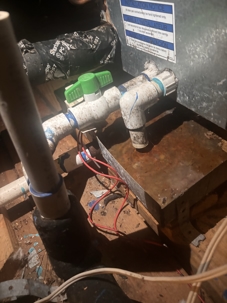Every second job we get during the summer is a leak from the ceiling — and almost every time, the culprit is the clogged AC condensate line.
Your AC doesn’t just cool the air — it also removes humidity. That moisture drains through a small PVC pipe (the condensate line). When it clogs with algae or sludge, water has nowhere to go… so it overflows into your ceiling.
Here’s how to keep it clear:
Tools You’ll Need
- Funnel or squeeze bottle
- Distilled white vinegar (preferred) or bleach (harsher option)
- Clean rag
- Garden hose (optional)
Step-by-Step Instructions
1. Turn Off Your AC
Switch it off at the thermostat (breaker if possible) before starting.
2. Locate the Condensate Drain Line
Look for a white PVC pipe by your indoor unit. Inside, you’ll often see a capped T-shaped vent.
3. Check for Blockages
Remove the cap and shine a flashlight in. Standing water = clogged line.
4. Flush the Line
- Pour about 1 cup of vinegar into the line using a funnel.
- Let it sit for 30 minutes to break down buildup.
- Rinse with warm water if needed.
(Tip: Skip harsh chemicals like Drain-O — they can damage your pipes.)
5. Flush with Water (Optional)
If the line is very clogged, gently run water through it with a garden hose. Avoid high pressure.
6. Replace the Cap & Restart the System
Turn your AC back on and check that it drains properly over the next day.
Maintenance Tips
Do this every 1–3 months during cooling season: Your air conditioner works hardest during the cooling season, which means dirt, dust, and debris build up more quickly. Cleaning or replacing your air filter every 1–3 months helps keep airflow steady, reduces strain on the system, and improves indoor air quality. Skipping this step forces your AC to work harder, which not only increases energy bills but also shortens the life of the unit. Think of it as inexpensive insurance against bigger repair costs down the line.
Consider condensate drain tablets to prevent algae growth: As your AC runs, condensation drips into the drain line. This warm, damp environment is the perfect breeding ground for algae and mold, which can clog the line and cause water leaks. Condensate drain tablets are an easy, low-cost preventative measure — you simply drop one into the drain pan, and it helps keep the line clear by slowing algae and bacterial growth. Regular use can save you from messy water backups and potential water damage.
If water keeps backing up, your system may need a professional check for slope or line size: A little water around the drain line occasionally can happen, but if backups are a regular issue, it’s usually a sign of a deeper problem. The drain line may not have the proper slope to carry water away, or the line could be too small for the amount of condensation your system produces. These are not DIY fixes — a professional HVAC technician can evaluate the setup, make adjustments, and ensure your system drains properly. Addressing this early can prevent costly water damage and keep your AC running efficiently.
By taking just 15 minutes to flush your line, you can save yourself from a summer ceiling leak nightmare — one of the most common AC emergencies in Houston homes.

